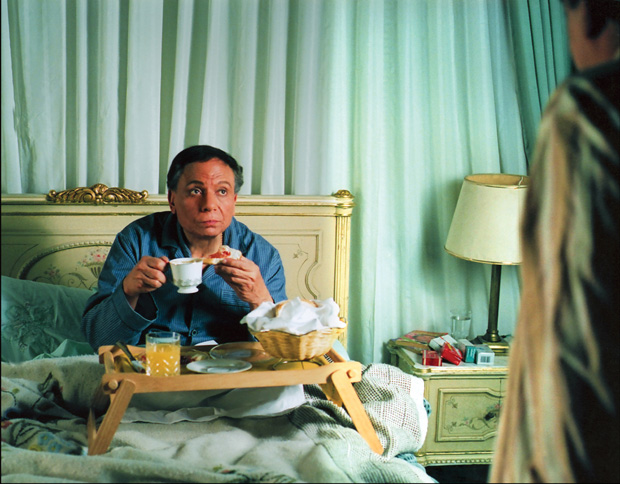Coptic characters are mostly portrayed as sidekicks in Egyptian cinema, but there are a few notable exceptions in films that tackle more complicated issues, writes film critic Sherif Awad.
The portrayal of Copts in Egyptian cinema is a de rigeur topic in the aftermath of every violent incident between Muslims and Copts in a country that has seen a tumultuous five years since the January 2011 revolution. Coptic characters have for the most part remained secondary or as a sidekick to the main characters in Egyptian cinema, with few films and TV series representing the Coptic families in Egyptian cities or in Upper Egypt where a majority of Copts live. Egyptian filmmakers also found their scripts caught between the scissors of the local censorship and the concern of the Coptic Churches when it comes to tackling critical subjects like marriage, priesthood or monasticism.
Just before the two Egyptian uprisings in 2011 and 2013, few films made during Mubarak’s era featured Coptic characters. In Film Hindi (Indian Film, 2003) by Mounir Rady, Rasha Mahdy played a young Coptic woman called Mary who falls in love with her Muslim neighbor Sayed, played by comedian Ahmed Adam. In Yacoubian Building (2006) by Marwan Hamed, Ahmed Rateb played Fanous, the Coptic secretary of the aristocratic Zaky El-Dessouky, played by Adel Imam.
[caption id="attachment_440891" align="alignnone" width="620"] Yacoubian Building[/caption]
Yacoubian Building[/caption]
In Hassan & Morkos (2008) by Ramy Imam, Omar Sharif played a Muslim religious sheikh who hides as a Coptic priest and befriends a real priest who also takes the identity of a Muslim due to their fears of fundamentalist violence. One should note that these characters were created as part of state propaganda about the harmony and unity between Muslim and Copts without any deep diagnosis of the contextual social turmoil. Scripts were clearly reminiscent of the tarbeya kawmeya (civic duty) textbooks we studied during our school years.
Yet there are a few films that have successfully managed to reflect the difficulties of Coptic problems in a realistic way. The divorce and remarriage of a middleaged woman played by Ilham Shahin was well depicted in the award-winning One-Zero (2009) by Kamla Abou-Zekry. In 2004, I Love Cinema by Ossama Fawzy depicted the story of a Coptic child who falls in love with the magic of cinema in the 1960s only to face the rejection of his religious and old-fashioned father. The film was granted a release certificate after a long fight with the censors that lasted four years.
With the numerous privately owned TV channels, some TV series started to create Coptic characters among the ensemble casts. Last Ramadan, Hala Sedky played Zeinat, a fanatic woman living in the Jews Alley by Mohamed El-Adl. The series was set during the late 1940s.
In the 1960s, Egyptian society was very different. There were no problems or confrontation between Muslims and Copts in Egypt. That’s why films like Shafika the Copt and The Nun, both starring Hend Rostom and directed by Hassan El-Imam, were calmly received by critics and audiences during that period. The first was a biography of a real-life bellydancer who lived in the first quarter of the century while the second was about a singer who gives up her money and fame and decides to become a nun.
Themes of romantic involvement between between Muslim men and Coptic women, however, have always been problematic even before the 2000s. In 1954, the censors banned El-Sheikh Hassan starring Hussein Sedky as the title character, a devout Muslim man who falls in love with a Coptic woman. The film was banned by President Mohamed Naguib and only given the green light by President Nasser after Sedky, who was also the film’s director, recut the film and added alternative scenes.
One film that surprisingly slipped through the censors’ fingers was Leqaaa Honak (Meeting There) by Ahmed Diaa El-Deen. The 1976 drama features a love story between a young Muslim man played by Nour El-Sherif who falls in love with his Coptic neighbor Yvonne, played by Soheir Ramzy. Fast forward some four decades later and the theme is still problematic. In 2011 a similar subject was treated by Hesham Issawi in Cairo Exit, only to see the film banned in Egyptian cinemas although it was screened in international festivals like Tribeca and Dubai. In 2013, it was finally granted a permit for local release although it was too late for it to generate any box office makings.
An even pricklier issue is showing God, the prophets or any of the disciples in human form; all such productions are categorically banned by not only the censors but by Al Azhar. But after The Passion of the Christ (2004) was granted permission for local release at Egyptian theaters, scriptwriter Fayez Ghaly dreamt of bringing his script about the voyage of Jesus and Miriam to Egypt to the screen. However, his passing away in 2014 before securing any Egyptian producers has prevented the script from seeing the light.
Comments
Leave a Comment